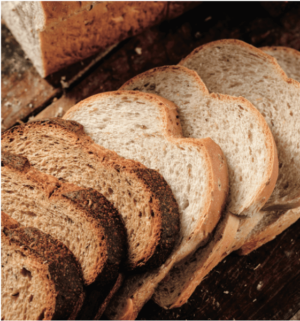What Is Amazake?
For many years rye bread in America has been found mainly in the form of Jewish rye. While many people enjoy this bread, ourselves included, it barely has any rye in it! Most of the Jewish rye that you find nowadays contains no more than 5 percent rye flour.
Deep, dark, richly delicious rye breads like those found in Ukraine, Scandinavia, and Germany are hard to come by. Thankfully there are more and more small-batch bakeries making rye breads that actually contain large amounts of rye.
Working With Rye
Rye is notoriously hard to work with, especially when your goal is to create a bread with a soft and pillowy crumb, as it is dense and heavy, and when used for bread can result in something with the texture of a hockey puck.
While this is a style of bread that many people enjoy, there are just as many who want something light and fluffy.
We’re not exactly sure why or how, but for some reason koji has the ability to lessen the density of a rye bread and allow you to create a light and fluffy bread even with a heavy ratio of rye.
As time goes on we hope to get this bread into the hands of a scientist who can fully analyze it and tell us exactly what’s going on.
RECIPE: Amazake Rye Bread
Until then we’ll keep making this rye bread that Jeremy developed for Larder, which uses 50 percent rye flour yet eats like the light and fluffy Jewish rye breads that most of us are accustomed to.
This bread uses the sour amazake from chapter 6 in its hydration, which serves to give the bread the pleasant tang that is found in many sourdough breads, without using a starter. At Larder this bread can more than stand up to the spicy mustard, sauerkraut, and bold pastrami in our signature sandwich.
It also makes for an excellent cracker when the loaf is sliced thin and baked until crisp. A personal favorite for us is to slather it with butter and cream cheese and then top it with caviar.
Ingredients
- 200 g water
- 200 g amazake
- 44 g molasses
- 3 g instant yeast
- 245 g rye flour
- 245 g high-gluten flour
- 8 g + 8 g wild carrot seed
- 8 g + 8 g caraway seed
- 8 g + 8 g mustard seed, equal parts yellow and brown
- 12 g + 8 g salt
- 8 g toasted yeast (for topping )
- 1 large egg
Procedure
- In a mixing bowl, mix the water, amazake, and molasses. In a separate bowl, combine the yeast, flours, and the first portion of the spices and salt.
- Gradually stir the dry ingredients into the wet using a dough whisk or spoon until the flour is well incorporated. Cover with plastic and let rest for 15 minutes. After about 15 minutes, mix again for a minute or two. Again let rest for 15 minutes and mix one more time as before. Now cover the bowl with plastic and let sit at room temperature for roughly 12 to 14 hours.
- After the long proof, stretch and fold the dough and shape it into boule or batard (round or torpedo) shapes for baking. Cover again with plastic and let rest for 15 minutes before putting in a proofing basket for the final rise. If you don’t have a proofing basket, line a bowl with a well-floured kitchen towel and put the dough in there for the final rise. The final rise should last somewhere between 1 and 1.5 hours. Keep the dough covered with plastic to prevent it from drying out.
- Preheat your oven to 350°F (176°C) half an hour before baking. Score the dough with a razor or sharp serrated knife. Beat the egg with water to make an egg wash. Mix the spices (second measurement) and yeast together and toast for a few minutes in a sauté pan over medium heat. Season the egg-washed dough with the toasted spices and yeast. Bake until the internal temp is about 200°F (93°C). Let cool completely before eating.


